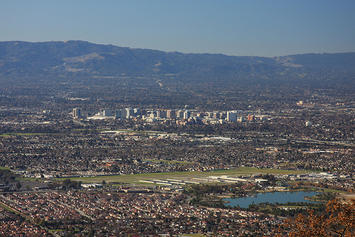
For the past half-century, California has dominated America’s tech industry. From the development of precision farming to the incubation of aircraft, space, semiconductors and computer systems, this state has emerged time and again at the cutting edge of future industries.
That is, perhaps, until now. In a stunning procession in December, California lost the leadership of three iconic firms — Hewlett Packard Enterprise, Oracle and Tesla — all to Texas, which this year even took the Rose Bowl’s place in hosting the college football playoff. In addition, many California tech firms, including Uber and Lyft, as well as Apple, have been shifting jobs outside the state.
This has been widely described as California’s “tech exodus.” Though it’s still less than a torrent and more a steady, long-term drip, it augurs some very bad trends. In recent years, California has been losing market share of innovative industries compared with 11 states with high concentrations of innovation-oriented firms, according to research by Ken Murphy, a professor at UC Irvine’s business school.
Since 2005, California’s share of the number of firms in the innovation sector (composed of 13 of the nation’s highest-tech, highest R&D advanced industries) has shrunk while competitors like Florida, Oregon, Arizona and Utah have expanded their share slightly.
The pandemic-induced push to move work online could hasten this shift. With 2 out of 3 tech workers willing to leave the Bay Area if they could work remotely, Big Tech could readily spread talent and wealth to other states.
Increasingly, California’s cities must compete with metro areas in Texas, Tennessee and even parts of the Midwest. Housing prices are a particularly critical concern: California has all three of the most unaffordable metro regions for first-time home buyers, according to a recent AEI survey, and six of the top 10. The flow of tech workers during the pandemic has gone to places like Phoenix, Dallas-Fort Worth and Raleigh, N.C., and away from big coastal cities with higher living costs.
Software-based tech companies can access knowledge workers outside California, and often at lower costs. At the same time, states like Texas and Arizona have been sought to replicate the California formula for tech industry growth — public university expansion, more suburban housing and public investment in downtowns, all meant to appeal to workers and their bosses.
California’s early emergence in both the aerospace and computer-related industries was strongly tied to physical proximity. The development of the aerospace sector, largely funded by the federal government, required close cooperation between designers and suppliers. This made the state, notably the Los Angeles area, unmatched as a center of aerospace development.
The semiconductor industry grew out of related companies like Fairchild Semiconductor, Intel, National Semiconductor and Advanced Micro Devices working together with customers like Hewlett Packard. That formed the basis for Silicon Valley’s remarkable growth and created lots of well-paying jobs for a generation.
But more recently, as the tech industry becomes more virtual and services-based, the companies’ workforces have less of a need to all be in one place. While these companies create vast wealth for a relatively small group of people, this is not a formula for broad-based economic prosperity.
Read the rest of this piece at Los Angeles Times.
Joel Kotkin is the author of The Coming of Neo-Feudalism: A Warning to the Global Middle Class. He is the Presidential Fellow in Urban Futures at Chapman University and Executive Director for Urban Reform Institute. Learn more at joelkotkin.com and follow him on Twitter @joelkotkin.
Marshall Toplansky is a clinical assistant professor of management science at the Argyros School of Business and Economics at Chapman University. He is a research fellow at the university’s Hoag Center for Real Estate and Finance and at the Center for Demographics and Policy.
Photo credit: TahoeGuy via Flickr under CC 2.0 License.












